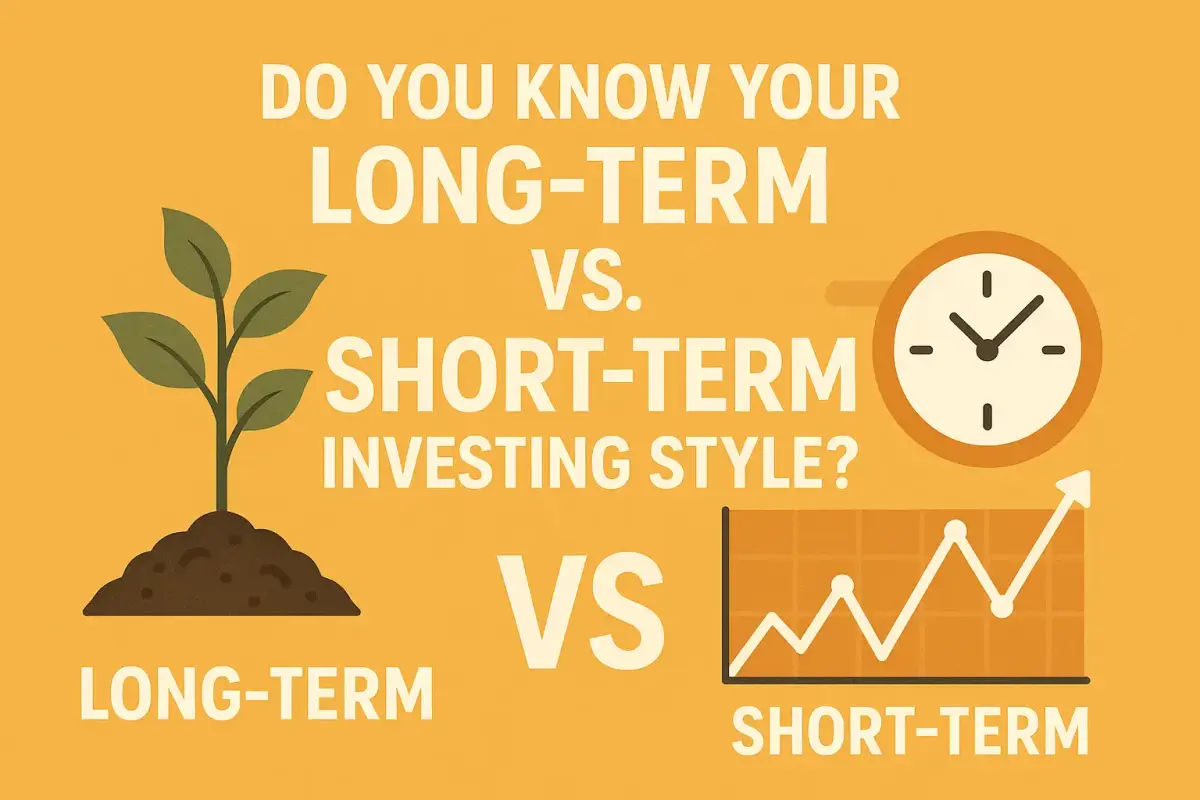निवेश करना उस पैसे को बढ़ने का एक अच्छा तरीका है, लेकिन निवेश करने के लिए इतने सारे अलग -अलग तरीकों के साथ, यह जानना मुश्किल हो सकता है कि आपकी स्थिति के लिए कौन सा तरीका सबसे अच्छा है। अल्पकालिक और दीर्घकालिक निवेश के बीच अंतर को समझना वित्तीय लक्ष्यों के साथ संरेखण में सूचित निर्णय लेने में मदद करता है। इस ट्यूटोरियल में, हम दोनों रणनीति पर चर्चा करते हैं, प्रत्येक की ताकत और कमजोरियों का विस्तार करते हुए, जोखिम बनाम इनाम, और इसे आपकी व्यक्तिगत स्थितियों के संदर्भ में कैसे माना जाना चाहिए।
दीर्घकालिक निवेश: समय के साथ पैसा बनाना
दीर्घकालिक निवेश अक्सर खरीद-और-पकड़ निवेश से जुड़ा होता है जिसमें निवेशक बहुत लंबे समय तक इसे पकड़ने के इरादे से एक संपत्ति खरीदते हैं-कई मामलों में, संभवतः दशकों तक भी। तकनीक आपके मूल निवेश के साथ -साथ आपके द्वारा जमा किए गए लाभ के साथ -साथ आपके मूल निवेश पर पैसा कमाने की शक्ति का उपयोग करती है। दीर्घकालिक निवेश धैर्य और अनुशासन के बारे में है, जिससे बाजार में उतार-चढ़ाव के बावजूद समय के साथ निवेश बढ़ सकता है।
लंबी अवधि के लिए निवेश क्या है:
- बहुत लंबे समय तक निवेश रखें (खरीद-और पकड़)।
- एकाधिक भत्तों: अधिक पैसा बनाने के लिए निवेश में धन को फिर से बनाना।
- कम अस्थिर: अल्पकालिक बाजार झूलों से प्रभावित नहीं।
संक्षिप्त निवेश: तेजी से अवसर का अधिकतम लाभ उठाना
जब आप लंबे समय तक निवेश करते हैं, लेकिन शेयरों को जल्दी से खरीदते हैं और बेचते हैं, तो आप अल्पकालिक निवेश में लगे हुए हैं, जिसका अर्थ आमतौर पर कुछ दिनों से कुछ महीनों से होता है। यह दृष्टिकोण मूल्य परिवर्तन और बाजार प्रवाह के माध्यम से अल्पकालिक लाभ की तलाश करता है। यह बहुत जल्दी आकर्षक हो सकता है, लेकिन अविश्वसनीय रूप से खतरनाक भी है क्योंकि यह सट्टा है।
यहाँ आपको अल्पकालिक निवेश के बारे में क्या जानना चाहिए:
- फोकस में ट्रेडिंग: लगातार खरीदना और बिक्री करना।
- त्वरित लाभ: बाजार में तत्काल चाल के आधार पर पैसा कमाने का प्रयास।
- उच्च अस्थिरता: इस तरह के फंडों में बाजार की चाल के लिए अधिक संवेदनशीलता होगी।
या तो दृष्टिकोण के पेशेवरों और विपक्ष
लंबी अवधि के लिए एक आंख के साथ निवेश करना
पेशेवरों:- कम जोखिम: अल्पकालिक बाजार gyrations का प्रभाव कम होता है।
- स्थिर कमाई की वृद्धि: समय के साथ बड़ी रकम जमा करने का अवसर।
- कम समय निवेश - कम जाँच आवृत्ति।
- रिटर्न में समय लगता है: आपको अचानक बड़े पैमाने पर रिटर्न नहीं मिलता है।
- बाजार निर्भरता: बाजारों का दीर्घकालिक प्रदर्शन सफलता निर्धारित करता है।
अल्पकालिक निवेश
पेशेवरों:- त्वरित रिटर्न: त्वरित रिटर्न का अवसर।
- सक्रिय जुड़ाव: यह हर समय काम कर रहा है।
- अधिक जोखिम: बाजार में उतार -चढ़ाव के संपर्क में वृद्धि।
- समय लेता है: समर्पित और सुसंगत फोकस की आवश्यकता होती है।
सही तरीके से उठाना
आपकी जोखिम सहिष्णुता, वित्तीय उद्देश्य और जीवन शैली सभी को आपकी निवेश रणनीति के अनुरूप होना चाहिए। यदि आप जोखिम की तरह नहीं हैं और आप चाहते हैं कि समय के साथ आपका पैसा बढ़े तो आपके लिए दीर्घकालिक निवेश हो सकता है। दूसरी ओर, अल्पकालिक निवेश आपके लिए बेहतर हो सकता है यदि आपके पास अक्सर व्यापार करने का झुकाव है और अधिक जोखिम लेने का मन नहीं है।
निवेश करने के अच्छे तरीके
दीर्घकालिक कमाई और निवेश करने के लिए विकल्प:
- जो फंड साझा किए जाते हैं
- ईटीएफ (ईटीएफ पर विवरण के लिए निम्नलिखित देखें)
- अपने दम पर स्टॉक
अल्पकालिक निवेश विकल्प:
- दैनिक व्यापार
- व्यापार विकल्प
- झूलों में व्यापार
दो दृष्टिकोणों के बीच संतुलन बनाना
और यह काफी महत्वपूर्ण है कि प्रत्येक वित्तीय रणनीति में, विविधीकरण है। लंबी अवधि की स्थिरता और अल्पकालिक क्षमता दोनों के एक पोर्टफोलियो का निर्माण आपकी समग्र धन को बढ़ाते हुए आपकी अल्पकालिक जरूरतों को पूरा करने के लिए किया जा सकता है।
Newbies के लिए सलाह
- बच्चे के कदम:छोटे निवेश करके शुरू करें और यह महसूस करें कि आपको लगता है कि प्रत्येक विधि कैसे काम करती है।
- सीखना:विभिन्न बाजारों और निवेश के तरीकों की खोज करें।
- अपने पोर्टफोलियो में विविधता लाएं:अपने जोखिम को कम करने के लिए, अपने सारे पैसे एक टोकरी में डालने से बचें।
- नियमित रूप से समीक्षा करें:जब आपकी वित्तीय स्थिति बदल जाती है तो अपनी योजना को अपडेट करें।
याद रखें, निवेश एक ऐसी प्रक्रिया है जिसे आपको निगरानी और अनुकूलन करना जारी रखना चाहिए, क्योंकि आपके लक्ष्य और परिस्थितियां विकसित होती हैं। यदि आप अपने लिए एक मजबूत वित्तीय भविष्य का निर्माण करना चाहते हैं, तो सूचित रहना और अपनी योजनाओं को बदलने के लिए खुला रहना एक आवश्यक दृष्टिकोण हो सकता है चाहे आप छोटे या दीर्घकालिक लक्ष्यों के लिए बचत कर रहे हों या निवेश कर रहे हों।


